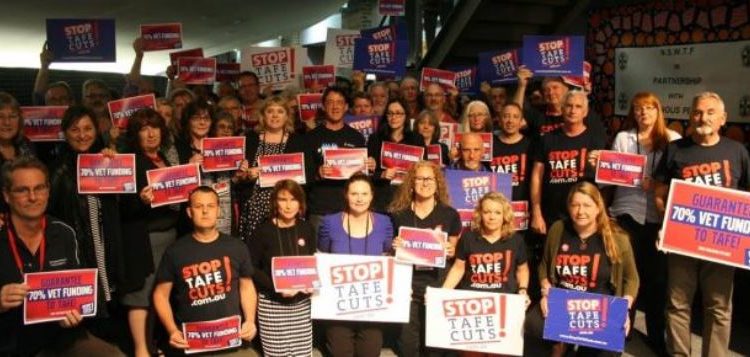La erosión del sistema de formación profesional de Australia, en parte debido a la privatización, ahora está afectando a la sociedad y al futuro de los jóvenes
Por: Internacional de la Educación.
Después de recortes presupuestarios severos durante la última década en Australia, el programa de formación profesional de countryrsquos TAFE, educación técnica y avanzada está en crisis El número de estudiantes ha disminuido en más del 25 por ciento desde 2012 y el sector TAFE ha sido particularmente afectado por la pérdida de empleos. fue dirigido por la Unión Educativa Australiana AEU miembro de la Internacional de la Educación EI en su conferencia nacional El futuro de las instituciones públicas TAFE – nueva política social el 20 de octubre El objetivo del evento fue reimaginar el papel de TAFE a la luz de un asentamiento en educación vocacional en Australiardquo Sector diezmado En el pasado reciente, los sistemas TAFE han sido diezmados por los recortes al financiamiento de miles de reducciones de personal docente en cierres de campus, una disminución en el rango de cursos y aumentos de tarifas para estudiantes queexcluir a los más necesitados ldquoNecesitamos una política pública sólida para las instituciones TAFE que reconstruyan su rol social más amplio permitiéndoles satisfacer las necesidades de los jóvenes y sus comunidades, así como las necesidades de la industria «, dijo Pat Forward AEUrsquos Federal TAFE Secretary ldquoA público bien provisto.
El sistema TAFE es el eje de esa política. Es la responsabilidad del gobierno australiano financiar adecuadamente el sistema y valorar a ldquoTAFE como una institución pública vital para construir una sociedad mejor. Agregó nuevas investigaciones. La conferencia reunió a académicos e investigadores, incluida la profesora asociada Leesa Wheelahan de el Dr. Jim Stanford de la Universidad de Toronto Director del Centro de Trabajo Futuro del Instituto de Australia y el Profesor John Buchanan Director de la Disciplina de análisis de negocios en la Universidad de Sydneyasí como maestros y representantes sindicales. La conferencia también fue sede del lanzamiento australiano de Wheelahan y Gavin Moodiersquos.
Global Trends in TVET un marco para la justicia social. EIrso. Angelo Gavrielatos director de proyecto de EIrsquos Global Response against the Commercialization and Privatization of Educación destacó los principales puntos del estudio La variedad de estructuras y enfoques educativos para este área de rápido crecimiento La necesidad de dar a los estudiantes más que capacitación centrada en el trabajo La importancia de adoptar un enfoque holístico para los estudiantes de EFTP El impacto negativo de la privatización en este sector La mejor práctica, es decir, Alemania, donde la TVET está financiada por el Estado y administrada por el estado La necesidad de que los estudiantes de EFTP puedan acceder a las trayectorias académicas hacia la educación superior si así lo eligen nbsp EILa TVET no cumple con las vías educativas ldquoTVET es un área crucial de desarrollo para hasta dos tercios de los estudiantes que no toman cursos académicos tradicionales enfocados en la universidad, dijo la presidenta de la IE Susan Hopgood ldquo El hecho de que se están posicionando en cursos a menudo del sector privado mal visto por la academia, pero convenientemente llenando un agujero en las estadísticas del gobierno necesita más investigación basada en la evidencia, como el estudio EFTP de EI, para ver qué está pasando realmente.
Añadió que este estudio destaca la necesidad del sector de TVET pero que no alcanza la promesa de proporcionar vías educativas para todos los estudiantesnbspldquoEl enfoque de capacidades productivas propuesto en el informe haría que los estudiantes de EFTP no solo recogieran habilidades, por ejemplo, en mecánica o peluquería, sino también aprendiendo habilidades de ciudadanía ydesarrollando una gama más amplia de capacidades para un lifetimerdquo.
Fuente: https://regions.ei-ie.org/asiapacific/detail_ap_news/?id=15485
Imagen: https://ei-ie.org/media_gallery/38292.jpg













 Users Today : 78
Users Today : 78 Total Users : 35459984
Total Users : 35459984 Views Today : 107
Views Today : 107 Total views : 3418572
Total views : 3418572